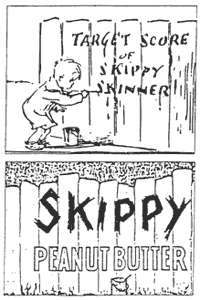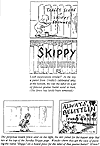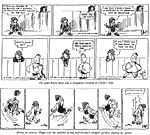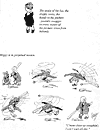| |
 Percy
Crosby and Skippy Percy
Crosby and Skippy
The Great Peanut Butter
Crime
Joan Crosby Tibbetts
calls it the Peanut Butter Conspiracy. She's vehement about it. And
some of her critics say she's demented. But I say she's more in the
right than they are. And if she seems a little obsessive at times, it's
probably because she's been frustrated to tears in a forty-year legal
battle to secure what is rightfully hers. A battle that, as of April 5, 2004, seems lamentably over. It all began March 15, 1923
when her father, Percy L. Crosby, master of one of the most individualistic
pen styles in the history of cartooning, introduced to the readers of
the old humor magazine Life a
new character, a kid named Skippy. It was the beginning of a national
love affair.
Crosby's graphic technique gave his kid creation vibrant life.
Even sitting down, Skippy Skinner seemed charged with motion. Crosby's sketchy, unlabored line has a ferocious energy, the vitality born of
pen tearing breakneck across paper, and Crosby's subjects were infused with that energy even when drawn in repose. And
the cartoonist's distinctive style of drawing is as much a part of his
nine-year-old protagonist's character as the gags that gave him personality.
Strangely, Skippy's anachronistic costume belies his character: attired
always in an English schoolboy's smock-like jacket, high Eton collar
with flaring bow-ribbon tie, and short pants, Skippy should be a well-behaved
momma's boy. Only his shapeless hat, tilted rakishly –provocatively,
almost belligerently –over his eyes and his down-at-the-ankle socks
betray him as a boy's boy, rowdy and roguish and just a trifle quarrelsome,
who swaggers into view with his hands jammed deep into his pockets,
strutting his neophyte machismo. Skippy proved so popular that Crosby,
who owned the copyright on the character, syndicated a daily strip version,
starting June 23, 1925. Distributed at first by bush league syndicates, Skippy was eventually taken up by Hearst's
King Features–a Sunday page in 1926; then in 1929, the dailies.
Skippy was a kid
strip of extraordinary authenticity. In addition to pursuing all the
usual kid activities–sandlot baseball and anything else that required
running at top speed–Skippy and a pal often simply sat for hours on
the curbstone (or hung over a board fence, a notable board fence), talking
the perfect logic but impractical sense of juvenile philosophy, arguing
and bickering about the monumental trifles of youth.
More significantly,
they were sometimes puzzled and unhappy and lonely–like real kids. And
the setting of the strip evoked the unexpressed horrors of the very
young. Skippy's small-town
landscape is often nearly barren, its horizon line perpetually unblemished
by houses or trees, a desert as bleak and comfortless as the world can
sometimes seem to a child.
During the next decade, Skippy became one of the nation's most well-read comic strips. The
perverse pronouncements of its young title character had charm as well
as street-wise wit and the insight of childhood. And Crosby became the toast of the town. He dined with John Barrymore one day and
Eugene O'Neill the next. His photograph appeared in the newspapers as
he attended the opening of another showing of his paintings or a book
signing of one of his best-sellers. Largely self-taught while on the
job as staff cartoonist and reporter artist for the
New York Globe (briefly) and then (for several years) for Pulitzer's
World, Crosby had too much energy to confine his efforts solely to his strip. He was
a creative volcano, waiting to blow. The details of Crosby's life are laid out in Jerry Robinson's 1978 biography of the cartoonist,
Skippy and Percy Crosby. It's a lovely book, copiously illustrated
with photographs and the inimitable Skippy strips. But the story Robinson tells
is a sad one, even tragic.
Crosby was born in Brooklyn December 8, 1891, but
when he was about nine, his parents moved to Richmond Hill, Long
Island, a small town
in farming community, and it is this locale with its open spaces that
Crosby would later make the setting in Skippy.
When his father became too crippled with arthritis to work, Percy left
high school without graduating and joined the work force, earning $10
a week at newspapers as a sketch artist reporter. He also freelanced
cartoons to magazines–mostly, to judge from his cartoons I've seen in
1914 issues of Life, about kids in the poorer sections
of big cities, always a popular subject in the magazine cartoons of
the day. Crosby enlisted in the Army during World War I, served in France
(and sent cartoons about military life to syndicates back home), was
awarded a Purple Heart and Victory medal, and, upon return to New York,
studied art at the Pratt Institute and in the Art Students League. At
the same time, he also freelanced cartoons to magazines, and his work
appeared, again, in Life and other publications. He did a great many more cartoons about
urban kids, and then, in 1923, Skippy swaggered across Crosby's drawingboard.
During Crosby's peak years of production (between, say, 1925 and
1940), he spewed out 14 books–novels (often about Skippy, with whom
Crosby identified very closely), poetry, and essays on philosophy, politics,
literature, and art. In 1931, Paramount produced two films about Crosby's strip characters, "Skippy" and "Sooky" (Skippy's
pal). Jackie Cooper was launched on his career as a child star in "Skippy";
the film was nominated for three Academy Awards, and its director, Norman
Taurog, won an Oscar for it. In addition to writing novels and tracts
and producing Skippy, Crosby also painted in oil and watercolor, and he crusaded for individual rights
and freedom of the press–and against Prohibition, bootleggers, gangsterism,
atheism, naval disarmament, and pacifism. Increasingly, he took his
crusades into the comic strip. And when editors wouldn't print these
diatribes, he took full-age ads in large metropolitan newspapers to
air his views. (Skippy, his alter ego, often philosophized on Crosby's favorite subjects. Once when an editor had the temerity to object to
Crosby's fulminating in the strip, Crosby wrote back: after wondering
if the editor permitted his readers to stay up past 9 p.m., he told
the editor that he took orders from no one, and then he nonchalantly
removed the paper from the strip's list of subscribers.)
Tragically, Crosby was eventually
consumed by his passions. His crusades became more furious, and he began
to imagine that the objects of his tirades were plotting to ruin him.
Increasingly throughout the forties, he made Skippy his mouthpiece,
and finally, King Features sought to rein him in. Crosby wouldn't agree to the terms of the renewal contract he was offered, so
the strip died on December 8, 1945. Four years later–his marriage in shambles, separated
from his children (his wife had taken them with her when she left in
1939, unable to endure his drinking bouts and crusading any longer),
income dwindling to nothing, unable to find a public forum, and drinking
heavily–Crosby attempted suicide. On December 16, 1948, he slashed his wrists and stabbed himself in the chest
at his New
York
apartment. Diagnosed as a paranoid schizophrenic, he was committed to
a mental institution where he spent the last 16 years of his life in
bitter isolation from all responsive human contact, desperately trying
to secure his release (he was scarcely insane by the standards of the
next generation), writing tracts in lucid, often brilliant prose that
no one would ever read, and drawing pictures of favorite subjects--horses,
dancers, skaters. But never Skippy. He never drew Skippy again.
One of the things that maddened Crosby was Skippy Peanut Butter.
From almost the beginning, Skippy had been thoroughly merchandised.
And Crosby hired a law firm to protect his copyrighted and trademarked
property, and he sued anyone who tried to use the name without his permission,
without paying him royalties. One of those he sued was Joseph Rosefield,
a California entrepreneur who had developed an inexpensive method
of making good peanut butter. He sold it under the name Peter Pan until
that contract expired, and then he started calling his peanut butter
Skippy. It began to appear on grocery shelves in the early 1930s. On
every jar was a white board fence with the word "Skippy" lettered
in youthful scrawl. That fence was taken out of Crosby's strip just as surely as the name was. Anyone who
read Skippy in those days
would recognize the name. And the fence. And it was precisely for this
reason, the high recognition factor, that Rosefield had chosen Skippy
as the name for his peanut butter.
 When Rosefield tried to register the name in the trademark office in
1933, Crosby blocked him. So Rosefield just retired from the field:
reportedly, he decided to market his peanut butter only in the West,
where Crosby, a devout New Yorker, would probably never hear about it.
As it turned out, Rosefield was doubtless right. Crosby either didn't hear about Skippy Peanut Butter in the West, or else by
the time he did, he was too involved in the larger crusades that animated
him in his last years on the strip to pursue the matter energetically.
Five days after Crosby slashed his wrists, Rosefield successfully registered
Skippy as his trademark–without mentioning that Crosby had contested him on the matter a quarter of a century before. And Skippy
Peanut Butter promptly went national. In 1955, Rosefield sold his rights
to the Skippy name to Best Foods for $6 million and was retained by
Best Foods as director of the Skippy Peanut Butter Division. In 1958,
Best Foods was acquired by CPC International, a conglomerate that sells
food stuffs under a variety of well-known names–Hellmann's, Mazola,
Knorr, and Mueller. And Skippy. When Rosefield tried to register the name in the trademark office in
1933, Crosby blocked him. So Rosefield just retired from the field:
reportedly, he decided to market his peanut butter only in the West,
where Crosby, a devout New Yorker, would probably never hear about it.
As it turned out, Rosefield was doubtless right. Crosby either didn't hear about Skippy Peanut Butter in the West, or else by
the time he did, he was too involved in the larger crusades that animated
him in his last years on the strip to pursue the matter energetically.
Five days after Crosby slashed his wrists, Rosefield successfully registered
Skippy as his trademark–without mentioning that Crosby had contested him on the matter a quarter of a century before. And Skippy
Peanut Butter promptly went national. In 1955, Rosefield sold his rights
to the Skippy name to Best Foods for $6 million and was retained by
Best Foods as director of the Skippy Peanut Butter Division. In 1958,
Best Foods was acquired by CPC International, a conglomerate that sells
food stuffs under a variety of well-known names–Hellmann's, Mazola,
Knorr, and Mueller. And Skippy.
In 1964, Crosby slipped into a coma in the mental ward at King's Park Hospital on Long
Island, and after
several months, he died. It was December 8, his 73rd birthday.
His daughter read about his death in a newspaper obituary. She hadn't
seen him–or heard of him–since 1939. But she was suddenly curious. His
case seemed peculiar. Almost suspicious. Why had her father been confined
so long? Who had kept him there? Why had there been no medical review
of his case? The hospital refused to tell her anything. The files were
sealed. They were confidential.
Her siblings asked her to be administrator of her father's
estate, and she and her husband Walter began examining the state of
his affairs. She went to her father's old law firm, the one he'd hired
to protect his trademark against those who would poach on the well-known
name. That firm, she discovered in some alarm, was now employed by CPC
International. When she tried to unearth documents at the patent office
division charged with examining trademarks, she was unable to find any
record of her father's 1933 objection to Rosefield's use of the Skippy
name. But she did discover that the director of that division had left
the federal bureaucracy and was employed by a Virginia law firm that subsequently defended CPC's right to
the Skippy name.
Crosby's former law firm refused to release any files on the
case until Joan signed a document releasing CPC from all claims. In
1977, she signed. "They wined us and dined us," she explained,
"and they told us they owned the name so I believed them. They
assured me they would pay royalties in the future, so I figured why
not sign the release."
CPC reportedly paid $25,000 for her signature. But no subsequent
royalties; paying royalties would be tantamount to admitting the legitimacy
of her claim. In an internal memo at the time, counsel for CPC admitted
that the company did "plagiarize" in "labeling some of
the Skippy comic concepts, notably the little boy and the fence."
Perhaps Joan learned of this shortly thereafter. Whatever
the case, she regretted signing the release, and in 1980, she and her
husband sued CPC, claiming the company owed the Crosby heirs millions for unauthorized use of the Skippy name. She lost the case.
Moreover, the court ruled that because CPC had invested so much in establishing
Skippy's good name as a peanut butter over the years, they were justified
in their claim that it was, by then, their name, not Crosby's.
But that wasn't the end of it. When the Tibbetts tried to
market carmel corn with Skippy and his fence on the label in 1986, CPC
sued the couple, and the court ruled that the name belonged to CPC,
not to Crosby's heirs. Thus, the daughter of the man who made the name
Skippy famous was ordered to stop using that name on food products she
and her husband manufactured and marketed. Her husband had a heart attack
in the midst of the litigation and died three years later. Some of the
lawyers Joan has hired agree that she has a valid case. But valid cases
don't always win, they are reported as saying. People–and corporations–with
deep pockets win. But Joan Crosby Tibbetts plodded on. She has assembled
files–10,000 documents in color-coded folders–that she said prove the
key point in a trademark dispute: by law, a trademark is protected only
because its owners use it and police it. And these documents, she says,
prove that Crosby did just that. She appealed her case, again and again.
The detailed, issue-by-issue, event by conspiratorial event, recitation
of her legal odyssey she rehearses on the Web, www.skippy.com; I won't review
it all here. It spans years. But the legal effort expired on April 5,
2004, when U.S. Supreme Court, to which she had finally appealed, declined
to hear her case. Tibbets, now in her seventies, vowed to continue her
battle in the court of public opinion. Waging her battle alone, she
has relied solely upon her personal financial resources; she faced a
huge corporation with virtually unlimited funding. In such contests,
the money usually wins. "The big corporations believe they can
just wear others down," Tibbets said. And of course she's right.
How would this case have been resolved if Skippy had been a character
in the Disney stable? Surely, we know the answer to that one.
As for the undercurrent of conspiracy that flows through
her recital, who can blame her for believing she's become enmeshed in
some bizarre plot against her? Her father kept a virtual prisoner for
16 years without any attempt being made to evaluate his case. His old
law firm now in the employ of his legal foes. Government officials ditto.
And then there's the IRS: every time she made a move towards CPC, she
got letters from the IRS, raising the spectre of an old disputed tax
claim. Maybe the conspiracy notion is a little far-fetched. But one
thing is certain, patently obvious to anyone who's read comic strips:
Skippy Peanut Butter is named after the famous comic strip character. Maybe Skippy Peanut
Butter is more famous now than Crosby's kid, but in the beginning, the
peanut butter used the kid's name to achieve public acceptance. CPC's
position has merit, no question: I don't doubt that it rests on firm
legal ground. But what is legal is not necessarily moral. And CPC should
be ashamed that it appears not to know the difference. It's too bad:
it makes good peanut butter, but I stopped buying it years ago–even
before they took the incriminating board fence off the label.
For more stories about the
great creators of comic books, check out a book of mine called The Art
of the Comic Book; for hints about its contents,
click here.
Return to Harv's Hindsights
|




